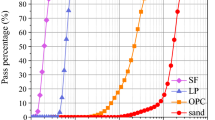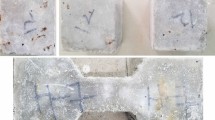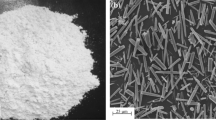Abstract
This paper presents the impact of fiber hybridization on performance of engineered cementitious composites (ECC). Mortar-based ECC demonstrates strain-hardening behavior with closely spaced several micro-cracks by using only 2% of fiber content. The novel characteristics of ECC can enhance the durability as well as service life of the cement-based structures. In current research work, metallic (steel) and non-metallic (polyester) fibers were used in combination to reinforce the ECC. The compression, four-point bending and electrical resistivity tests were carried out to characterize the behavior of various ECC mixtures. Test results indicated that the hybrid use of metallic and non-metallic fibers enhanced the performance of the cementitious composite. On the other hand, the utilization of industrial by-product (slag) and hybrid fibers saves the natural resources, land cost and contributes to make the eco-friendly environmental system.
Access provided by Autonomous University of Puebla. Download conference paper PDF
Similar content being viewed by others
Keywords
1 Introduction
In recent years, rapid advances have been made in the construction industry with the development of new cement-based products. According to present scenario high-performance fiber-reinforced cementitious composites (HPFRCC) is one of the best-suited cement-based products used for the construction purposes. The superior tensile and durability properties of HPFRCC products promote its use under aggressive environmental conditions. The HPFRCC products are designed with the optimized use of polymeric fibers and constituents. Engineered cementitious composite (ECC), reactive powder concrete (RPC) and strain-hardening cementitious composite (SHCC) products are the well-known examples of HPFRCC. From the above discussed products, ECC is the superb matrix in construction industry which is commonly known due to its bendable behavior and ductile performance. The design of ECC relies on micromechanical principle. Tight crack width (<100 µm) and excellent tensile strain capacity (1–8%) are the novel parameters of ECC which made it alter than other types of cementitious products [1]. The narrow crack width of ECC, controlled matrix fracture toughness and also exhibits excellent durability performance under susceptible conditions [2]. Sequential development of multiple tiny cracks in ECC results into strain hardening, which is similar to ductile nature of metal [3,4,5]. The novel characteristics and ductile nature of ECC promote its use in various cement-based structural applications. The cement consumption and cost of fibers minimize the use of ECC in large-scale structural application. Numerous research investigations reported that the composition of ECC mainly consists of finer size constituents and low content of polymeric fibers [6,7,8,9,10]. Therefore, to reduce the cost of ECC finer size constituents can be replaced with supplementary cementitious materials (SCM) in high quantity. Literature reported that fly ash as SCM and polyvinyl alcohol (PVA) fiber as internal reinforcement are the most widely used constituents for the typical ECC mixtures [1,2,3]. Fly ash is produced during the combustion of coal in thermal power plants. However, in present scenario most of the countries around the globe are moving fast toward the sustainable and green power generation. On the other hand, cement-based product manufacturers association has shown concern about the shortage in supply for good quality of fly ash. The PVA fibers are most widely used to reinforce the ECC; but high cost of these fibers limit the use of ECC in large-scale structural applications. PVA fibers are manufactured by some limited industrial groups/countries in the world which also limit its availability. Therefore, after observing all the above-discussed parameters, authors in current research work have tried to evaluate the performance of ECC with the utilization of high quantity of slag (iron industry waste) as SCM. Two different types of low cost and indigenous fibers, i.e., metallic (steel) and non-metallic (polyester) fibers, were used to reinforce the cementitious product. The hybrid use of these fibers was also used at different percentages to reinforce the ECC. The present study emphasizes on the impact of steel and polyester fibers in hybridization on various parameters of ECC matrix. Therefore, utilization of these products can save the overall cost, environmental ecosystem and also provides better guidelines for future design of ECC matrix.
2 Constituents and Mix Proportions
The powdered constituents selected during this research work were Portland cement (PC) confirming to IS 8112 (2013) [11] and ASTM C150 [12], fine river sand (RS), and slag (SL) (iron industry waste) as supplementary cementitious material. The two different types of fibers such as polyester (PET) and steel (SE) fibers were used in cementitious mixtures as internal reinforcement. Potable water confirming to IS 456:2000 [13] and high range water reducer admixture (HRWRA) were added into mixed solid constituents to achieve the required fresh properties. In current investigation, 70% (of the total cementitious products) iron industry waste (SL) and non-degradable polyester fibers have been utilized in the cement matrix. The addition of high volume of waste product and low-cost fibers help in saving the natural resources, overall cost and contribute in making the eco-friendly sustainable cement matrix. To examine the influence of fiber hybridization on the performance of cementitious mixes, total six mixes were prepared. The proportion of selected constituents and designation of various cementitious mixes have been given in Table 1.
3 Experimental Program
3.1 Mixing and Casting Process
The mixing process of cementitious composites was done by using power driven mortar mixer as described below:
-
Firstly, all the selected powdered constituents (PC, RS, and SL) were added into the drum of mixer and thoroughly mixed at low speed for 2–3 min.
-
Then approximately 65% quantity of selected water and HRWRA were poured into the drum of mixer in rotating condition and the rotating process continued for 2 min.
-
After that, remaining part of liquid constituents was added into the mixed components and rotated the drum for another 2–3 min.
-
At last, the quantity of selected fiber (as per mix design) was slowly dispersed into the drum in rotary condition and allowed to be mixed until the homogenous mix was not achieved.
In current investigation, cubical and prism-shaped specimens of size 70.6 mm × 70.6 mm × 70.6 mm and 500 mm × 100 mm × 100 mm, respectively, were casted to record the compressive, electrical resistivity and flexural response of various mixes. After 24 h, the casted specimens were taken out and then kept into water for required curing age before testing.
3.2 Test Methods
3.2.1 Compression Behavior
To study the impact of fibers combination on compression behavior of various cementitious mixes, cubical-shaped specimens were casted and tested in the universal testing machine as per IS 516:1959 [14] and BS-EN-12390 part 3 [15] specifications.
3.2.2 Flexural Response
The impact of fiber combination on flexural response of various cementitious mixes has been recorded on prism specimens by performing four-point bending test as per IS 516:1959 [14] and BS-EN-12390 part 5 [16] specifications.
3.2.3 Electrical Resistivity (ER)
ER performance of cement-based products indicates its durability [17, 18]. It can represent the movement and distribution of ions through cementitious products. The impact of fiber combination on ER of various mixes has been recorded on cubical-shaped specimens by using two-point method. The ER (ρ) of the cementitious specimens was determined by using the following relationship.
where A is the area of cubical specimen (cm2), L is the length of the cubical specimen (cm), and R (\({\text{k}}\Omega\)), resistance of the samples.
4 Results and Discussion
4.1 Compressive Strength
The impact of fiber combination on compression performance of ECC mixtures at different curing ages is given in Fig. 1. It has been noticed from Fig. 1 that the ECC mixture made with PET fiber had lowest compressive strength; while, ECC mixture made with steel fiber had highest compressive strength. Hybrid use of both fibers in ECC mixtures strongly influenced the compressive strength of the cementitious matrix. The substitution of PET with SE fiber at 20%, 40%, 60%, 80%, and 100% enhanced the compressive strength of the matrix by 1.31%, 4.5%, 7.24%, 11.31%, and 13.01%, respectively, after 28d of water curing. It is observed from Fig. 1 that the matrix containing SE fiber performed better in terms of compressive strength as compared to mixes containing PET and hybrid fiber.
4.2 Flexural Strength
The influence of fiber combination on flexural strength of various ECC mixtures at different curing ages is given in Fig. 2. It has been observed from Fig. 2 that the ECC mixture made with PET fiber had lowest flexural strength; while, ECC mixture made with steel fiber had highest flexural strength. Hybrid use of both the fibers in ECC mixtures enhanced the flexural strength of the cementitious matrix as compared to H1 matrix. The substitution of PET with SE fiber at 20%, 40%, 60%, 80%, and 100% enhanced the flexural strength of the matrix by 2.11%, 5.07%, 8.46%, 12.12%, and 15.09%, respectively, after 28d of water curing. It is observed from Figs. 1 and 2 that the mixes containing SE fiber gave better performance in terms of strength parameters as compared to mixes containing PET and hybrid fiber. The high modulus of SE fiber and strong bonding between fiber and cementitious mixtures were responsible for the enhancement in strength parameters.
4.3 Deflection Capacity
The impact of fiber hybridization on deflection capacity of various ECC mixtures at different curing ages is given in Fig. 3. It has been observed from Fig. 3 that the ECC mixture made with SE fiber had lowest deflection capacity; while, ECC mixture made with PET fiber had highest deflection capacity. Hybrid use of both the fibers enhanced the midspan deflection capacity of the cementitious matrix as compared to H6 matrix. The substitution of PET with SE fiber at 20%, 40%, 60%, 80%, and 100% decreased the deflection capacity of the cement matrix by 3.97%, 12.06%, 22.14%, 26.11%, and 34.21%, respectively, after 28d of water curing. It is observed from Fig. 3 that the mixes containing PET fiber gave better performance in terms of deflection capacity as compared to mixes containing SE and hybrid fiber. Deflection performance of all the ECC mixtures was opposite than strength parameters. The low modulus, better elongation capacity, and slip-hardening behavior between PET fiber and cement matrix were responsible for the enhancement in deflection capacity. Numerous research investigations reported that the inclusion of low modulus fiber improved the ductile performance of the cement matrix [19, 20].
4.4 Electrical Resistivity (ER)
The impact of fiber hybridization on ER of various ECC mixtures at different curing ages is given in Fig. 4. It has been noticed from Fig. 4 that the ECC mixture made with SE fiber had lowest ER; while, ECC mixture made with PET fiber had highest ER. Hybrid use of both the fibers enhanced the electrical resistivity of the cementitious mixes as compared to fully steel fiber containing ECC matrix (H6 mix). The substitution of PET with SE fiber at 20%, 40%, 60%, 80%, and 100% decreased the ER of the cement matrix by 4.69%, 11.97%, 22.16%, 31.06%, and 42.07%, respectively, after 28d of water curing. Matrix-containing PET fiber gave better performance in terms of ER as compared to mixes containing SE and hybrid fiber. The electrical conductivity of the PET fibers is very low and their inclusion makes a good bond with cement matrix, which was responsible for the better ER of ECC mixes. On the other hand, the steel is conductive material due to which the ER of ECC mixes containing SE fiber was found lower. Published literature reported that the inclusion of steel fiber decreased the ER of the cement matrix [21]. Therefore, in current investigation, the results obtained from mechanical and durability parameters revealed that the successful utilization of high volume of waste product with low cost and non-degradable fibers enhanced the overall performance along with promoting matrix sustainability.
5 Conclusions
In the current research investigation, the performance of ECC mixes containing fibers in hybridization was evaluated in terms of compressive strength, flexural strength, deflection capacity, and electrical resistivity. This study also emphasizes the impact of polyester (PET) and steel (SE) fiber as internal reinforcement in ECC mixes. The major key findings from the current research work have been mentioned below:
-
Inclusion of SE fiber in ECC mixes gave better performance in terms of strength parameters as compared to PET and hybrid fiber containing cementitious mixes. The high modulus of SE fiber and strong bonding between steel and cementitious mixtures was responsible for the enhancement in strength parameters.
-
Deflection capacity performance of all the ECC mixtures was opposite than strength parameters. Inclusion of PET fiber in cementitious mixes gave better performance in terms of deflection capacity as compared to SE and hybrid fiber containing mixes. The low modulus, better elongation capacity, and slip-hardening behavior of PET fiber with cementitious products were responsible for the enhancement in deflection capacity.
-
Electrical resistivity of ECC mixture made with PET fiber was highest than other mixes. PET fibers are very low electrically conductive, and their inclusion reduced the porosity which was responsible for the better ER performance.
-
Findings from current investigation depicted that the inclusion of metallic fibers improved the strength parameters while the inclusion of non-metallic fiber enhanced the ductile and durability parameters of ECC matrix made with slag. Therefore, the present investigation recommended that the hybridization of both the fibers was better option for the use in cementitious mixes.
-
Examination from this study revealed that the addition of waste, non-degradable materials, low cost, and superior performance of cement matrix enhanced the durability and sustainability of the matrix.
References
Singh M, Saini B, Chalak HD (2019) Performance and composition analysis of engineered cementitious composite (ECC)—a review. J Build Eng 26:100851. https://doi.org/10.1016/j.jobe.2019.100851
Li VC (2007) Engineered cementitious composites (ECC)—material, structural, and durability performance. In: Nawy E (ed) Concrete construction engineering handbook. CRC Press
Singh M, Saini B, Chalak HD (2018) Properties of engineered cementitious composites: a review. ICSWMD 2018, LNCE 21, 2019, pp 1–11. https://doi.org/10.1007/978-3-030-02707-0_54
Li VC (1998) Engineered cementitious composites—tailored composites through micromechanical modeling. Fiber reinforced concrete: present and the future. In: Banthia N, Bentur A, Mufti AA (eds) Canadian society for civil engineering. Montreal, pp 64–97
Li J, Yang E-H (2017) Macroscopic and micro structural properties of engineered cementitious composites incorporating recycled concrete fines. Cem Concr Compos 78:33–42
Singh M, Saini B, Chalak HD (2019) Appraisal of hybrid fiber reinforced engineered cementitious composite. In: Proceedings of the 4th international conference on civil, structural and transportation engineering (ICCSTE 19) Ottawa, Canada, 11th and 12th June 2019. https://doi.org/10.11159/iccste19.192
Li VC, Mishra DK, Naaman AE, Wight JK, LaFave JM, Hwai-Chung W, Inada Y (1994) On the shear behavior of engineered cementitious composites. Adv Cem Based Mater 1:142–149
Li VC, Hwai-Chung W, Maalej M, Mishra DK (1996) Tensile behaviour of cement-based composites with random discontinuous steel fiber. J Am Ceram Soc 79:74–78
Singh M, Saini B, Chalak HD (2020) Performance characteristics of ECC using micro fibers in hybridization. Ind Concr J 94:66–73
Dan M, Ting H, Zhang YX, Lee CK (2017) Mechanical behaviour of a polyvinyl alcohol fiber reinforced engineered cementitious composite (PVA-ECC) using local ingredients. Constr Build Mater 141:259–270
IS-8112 (2013) Specification for 43 grade ordinary Portland cement. Bureau of Indian Standards. New Delhi
ASTM-C150/C150M-16e1 (2016) Standard specification for Portland cement. ASTM International, West Conshohocken, PA
IS 456-2000 Plain and reinforced concrete-code of practice, 4th Revision
IS 516-1959 (2006) Methods of tests for strength of concrete, 18th edn. Bureau of Indian Standards, New Delhi
BS-EN-12390–3, Testing hardened concrete, Compressive strength of test specimens, British Standard Institution, 2009.
BS-EN-12390-5 (2009) Testing hardened concrete, flexural strength of test specimens. British Standard Institution
Medeiros-Junior RA, Lima MG (2016) Electrical resistivity of unsaturated concrete using different types of cement. Constr Build Mater 107:11–16
Broomfield JP (2007) Corrosion of steel in concrete, 2nd edn. Taylor and Francis, New York
Soe KT, Zhang YX, Zhang LC (2013) Material properties of a new hybrid fibre-reinforced engineered cementitious composite. Constr Build Mater 43:399–407
Li Q, Zhao X, Xu S, Gao X (2016) Influence of steel fiber on dynamic compressive behavior of hybrid fiber ultra-high toughness cementitious composite at different strain rates. Constr Build Mater 125:490–500
Banthia N, Djeridane S, Pigeon M (1992) Electrical resistivity of carbon and steel micro-fiber reinforced cements. Cem Concr Res 22:804–814
Author information
Authors and Affiliations
Corresponding author
Editor information
Editors and Affiliations
Rights and permissions
Copyright information
© 2021 The Author(s), under exclusive license to Springer Nature Singapore Pte Ltd.
About this paper
Cite this paper
Singh, M., Saini, B., Chalak, H.D. (2021). Impact of Fiber Hybridization on Performance of Engineered Cementitious Composite. In: Singh, H., Singh Cheema, P.P., Garg, P. (eds) Sustainable Development Through Engineering Innovations. Lecture Notes in Civil Engineering, vol 113. Springer, Singapore. https://doi.org/10.1007/978-981-15-9554-7_29
Download citation
DOI: https://doi.org/10.1007/978-981-15-9554-7_29
Published:
Publisher Name: Springer, Singapore
Print ISBN: 978-981-15-9553-0
Online ISBN: 978-981-15-9554-7
eBook Packages: EngineeringEngineering (R0)








